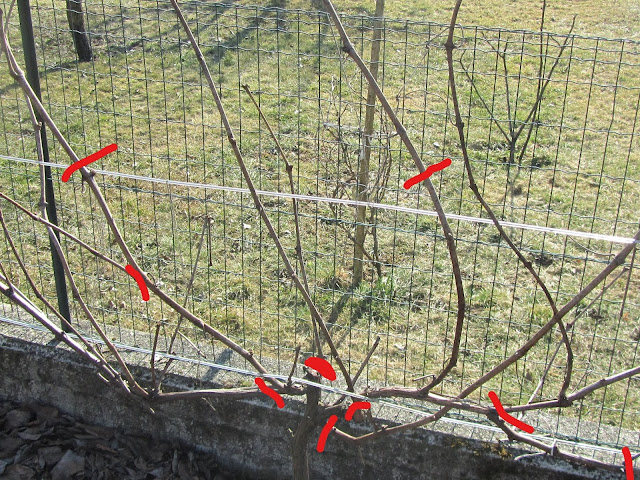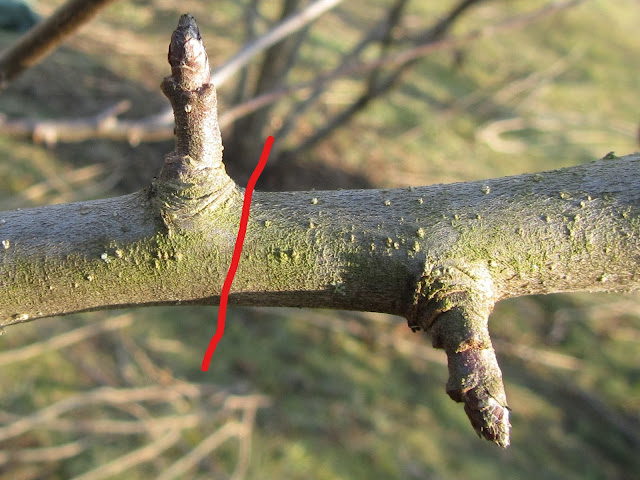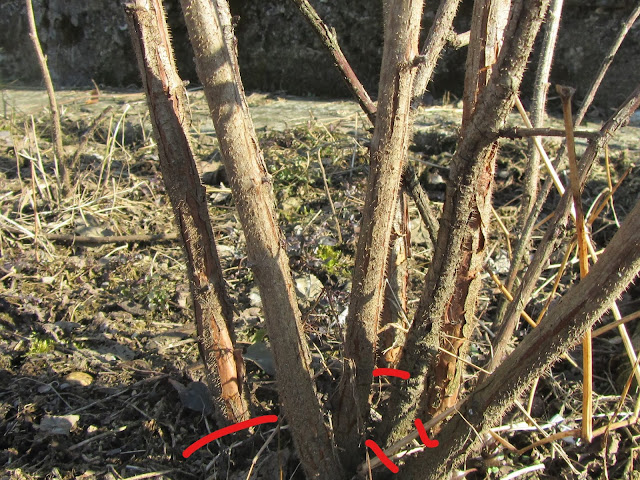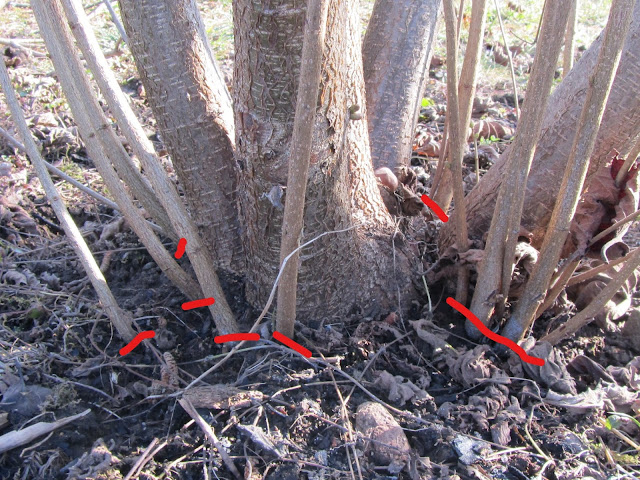There are dozens of pruning manuals, this one it is certainly not a pruning course and I will probably not say anything newhowever, I would like to bring together in one article what is known about the pruning and especially of fruit plants answering some simple questions that you will surely have asked yourself.
In nature, all plants hide, grow and bear fruit to perfection without any external intervention and, in principle, no plant would need pruning, it is enough to see in the mountains Meli and Peri now wild 10 meters high and perfectly fruiting.
Nonetheless pruning aims to maintain a balance between the vegetative and reproductive aspects and offers undoubted advantages:
The best time to prune depends on the species but, in principle, we could say that for most of the deciduous plants it is better to do it in the period of vegetative restor when they have now lost their leaves, but at least 15-20 days before the buds hatch.
The best period is therefore from November to February, avoiding periods of severe frost which could compromise the regular healing of wounds.
In very cold areas I recommend pruning between the end of February and the beginning of Marchin Southern Italy, on the other hand, it can be easily pruned in December.
Even evergreen plants are best pruned during vegetative rest, remembering that massive pruning stimulates vegetative recovery and that a growing plant is more sensitive to frost damage than a fully dormant one.
So far we have described dry pruning, however there is also the green pruning made in Summer only on excessively vigorous plants.
However, what has been said is not applicable to all species, if for example we observe the Japanese Medlar we realize that it begins to bloom in Autumn and that it bears fruit between April and June; this plant, in order not to compromise fruiting, must be pruned as soon as the fruits have been harvested.
Remember it’s always better to prune a little every year, rather than having to do drastic pruning every 5 years.
General Rules For A Good Pruning:
- Disinfect tools : I recommend cleaning the blades of your shears with alcohol and to pass them over the fire, so that all possible pathogens that could infect the pruned plant through the wounds of the cut are killed.
- Prune “Healthy” Plants First : although it is better to disinfect the tools with each new plant pruned, it is still good to start by pruning young and healthy plants, ending with the older and battered ones, so as not to transfer the diseases of the latter to the former.
- Cut Just Above A Gem : depending on the plant species, the buds can be spaced several centimeters apart; given that the new vegetation will be emitted by the gem closest to the cut, it is advisable that there is not much wood between the cut and the gem which, over the course of the season, would inevitably dry out.
- Making Oblique Cuts : if a branch is vertical, do not cut it parallel to the ground, but at an angle of 45 °. In this way the section of the cut will be inclined, avoiding the stagnation of water and various rot.
- Don’t Prune Big Branches : the younger and smaller a branch is, the better it will withstand pruning.
- Use Mastic : if you really need to prune a large branch, remember to use mastic, which helps the healing process, limiting the entry of pathogens.
- Making Clean Cuts : use sharp shears, making a sharp and clean cut, not “filleted”. The cleaner and more precise you are, the faster the wood will heal.
- Air the hair : for all species it is important that the foliage is not excessively dense and that the air (and light) can pass through it, reducing humidity and attack by pathogenic fungi, as well as ensuring better maturation of the innermost fruits.
- Select the last Gem : When making a cut, it must be in the vicinity of a gem. The bud closest to the cut will be the one that will emit more vigorous branches; consequently, given that the buds are oriented in all directions, it would be advisable for the bud closest to the cut to be oriented in the direction in which we want to direct the new vegetative flow; for example towards the outside of the canopy and not vice versa.
Types of Cutting:
- Thinning : means the total removal of a certain number of branches and is carried out in vigorous plants, which produce too many branches. This technique is also known as Long Pruning, as the remaining branches are not numerous, but they are long
- Shortening : in this case the branch is not completely removed, but simply shortened (sometimes even by more than 50%). Contrary to before, here we are talking about Short Pruning, as there are many branches left, but short.
- Scraping : pruning performed for health purposes; consists in the removal of the most external and dead part of the bark of adult trees.
- Return cuts : every year a branch emits shoots from the lateral buds, but also continues to lengthen from its vegetative apex. The return cut is made just above the branch between the main branch (the old one) and the twig (new). In this way, the old vegetative apex will be replaced with the new one and the excessive growth in length will be limited, rejuvenating the foliage and the branches that are now too old.
- Topping : removal of the vegetative apex (the tip) of the shoots. It is an example of green pruning (done between spring and early summer) and favors the growth and formation of new shoots along the axis of the branch.
- Suckering : removal of suckers, or those branches that sprout directly from buds located on the roots or from the collar.
- Capitozzatura : a very drastic type of pruning, with the removal of large branches, done in order to reinvigorate plants that are now old or to contain the size of the plants, such as in Linden. This technique, in addition to defacing the aesthetic aspect, cannot be performed on all species; in Conifers for example, would lead the plants to certain death.
How to prune fruit plants?
For arboreal plants the first intervention is known as training pruning so long as the healthiest and best arranged branches are selected, usually leaving 3 or 4, which will become the future main branches thus determining the shape of the adult plant.
Subsequently, the production pruning takes place, which requires the recognition of the different types of gems (flower, wood, mixed). The reproductive behavior of the different species is so variable that it cannot be generalized. For this reason I will give an explanation based on the following fruit plant groupings:
Kiwi and Vine: Both species they are climbing lianas the Vine is equipped with tendrils that easily anchor it to the supports, while the Kiwi, which is devoid of them, clings by wrapping itself around anything it encounters, often forming inextricable tangles.
Both species require massive pruning, which remove much of the old season wood. Also remember that both species bloom on the new shoots and therefore there is no clear distinction between flower and wood buds.
Eliminate most of the branches by selecting a certain number (which also varies according to the age of the plant and the space available), to be shortened until there are about 15 buds (in Kiwis) or 5-8 buds (in Vine). They are easy to prune plants, which bear abundant fruit (especially Kiwi) even if pruned by inexperienced hands.
To summarize, thin out and shorten the few chosen branches.

Peach: This species bears fruit mainly (not only) on one-year mixed branches and, healthy and well fertilized plants, have high vigor. The mixed branches are those even over 30 cm long, but of small diameter, given that they are only 1 year old and contain both flower and wood buds. They have to remove up to 70%trying to eliminate those inside the canopy, damaged or crossing. The rest should be shortened to about half length.
Cherry and Apricot: these fruit plants they do not like drastic pruning since the cuts do not heal well and are subject to gummy. That said, light but constant pruning is commonly done in manufacturing plants.
In the Apricot Tree the flower buds are slightly larger and usually present in pairs, divided by a central wood bud and are arranged along the entire mixed branch. The amount of pruning (thinning and shortening) will be proportional to the load of flower buds; in years in which there are many, more branches will have to be eliminated, in order not to incur alternation of production.
The Cherry Tree it mainly produces on the bunches of May, very short branches (1-2 cm) with a large group of flower buds.
In principle Cherry is a plant that develops harmoniously and elegantly even without pruning; however the large size requires a containment pruning, designed to reduce its size and facilitate harvesting.
Apple and Pear: the pome fruit usually they like energetic pruningbut it is important to know which are the buds on which the flowering / fruiting will take place.
We have to recognize the Lamburdeor small branches (2-3 cm) with a flower bud in an apical position, i Toast you slender branches ending in a flower bud and, finally, mixed branches.
During the vegetative phase the Lamburda grows, giving rise to a structure known as the Stock Exchangerich in nutrients. If Lamburdes and Bags are not adjusted with appropriate pruning, they bundle together, forming the typical Chicken (or Rooster) legs.
Depending on the variety of Apple, fruiting will focus more on Lamburde or Brindilli / Mixed Branches.
During pruning you will have to renew the Lamburdes with return cuts and thin out the hair thinning out badly positioned branches. The Brindilli should not be shortened, because they end with a flower bud, but they must be thinned out.
The Lamburdes that give rise to better fruit are usually those placed on 2-3 year old branches. An intelligent pruning tends to keep them constant, eliminating those inserted on branches that are now too old.
In principle the pruning of the Pear tree must be lighter than the Apple tree’s one.

Blackberries and Raspberries: these species are considered biennial plant sin the sense that the aerial part is completely renewed during this period.
Practically the roots are perennial and, at every season, they emit suckers that grow vigorously, sometimes for over 2 meters (especially in Blackberries), often bending down to touch the ground.
These branches (1 year branches) do not bear fruit, except in the Raspberries bifera. During the following season from the lateral buds of these branches some shoots are emitted at the apex of which flowers / fruits will be present.
At the end of the season these branches (2-year branches) die and dry out.
Pruning consists of eliminating all those dead branches (2 years old) and selecting 3-5 1 year old branches; the others will be removed at the base. Selected branches should be shortened by about half (or more), so that they are more stable. Don’t be afraid the flowers will be produced from the buds emitted by any bud of these branches, be it basal, lateral or terminal. Fruiting will therefore be generous regardless of how much you shorten them.
NB at the end of the second year the branches can be recognized both by the fact that they are dead / dry and by the presence of branches in the upper part.

Blueberries and Currants: are plants as relatively limited development although Blueberries can exceed 2 meters in height. In the currant, branches are shortened and the older ones thin out. In the Blueberry the flower buds are arranged on the 1 year old branches and are visually larger than the wood buds, pruning is very light sometimes superfluous and aims at thinning the foliage.
In the European plum treewhich blooms less copiously and mainly on mixed branches, the pruning will be lighter, renewing the mixed branches.
In both cases excess branches, broken or badly directed, must be eliminated, thinning out the internal part of the crown.
Very similar speech can be made for the Almond treesremembering that in rich soil they become much bigger trees than Plum trees and therefore it is it is advisable to carry out containment pruning, shortening the rising branches.
Olive tree: to be able to prune correctly you must remember that most pinkies (flower buds of the olive tree) they are produced on 1-year branches (between 20 and 40 cm long) and therefore fruiting will be concentrated on the latter; furthermore it should be considered that the Olive tree it is a very vigorous plant which, in suitable climates, can get really big.
Pruning must be done from year to year and consists ofelimination of the Polloni and the Succhionior those vigorous branches that sprout directly from the main branches.
In this species, more than in others, the return cuts and the lightening of the crown are important (the species is heliophilous and does not tolerate humidity)
Hazelnut and Pomegranate: these two species, which apparently seem very different, have one element in common; both have a tendency to release suckerseven in adult and healthy plants.
In the Hazel, a shrubby form is usually chosen, selecting 3-4 suckers, which will become the future trunks. At every season all the numerous suckers grown during the summer will have to be removed, shorten the branches that point upwards and streamline the foliagemaking sure that the branches occupy the available volume, without there being too dense and other free areas.
The Pomegranate it can grow both as a sapling and as a shrub; in the first case a single branch is selected, in the second case 3-4 are usually selected. In the future, especially if you want the “tree” shape you will have to remove all new suckers, which in a single season can reach the height of a man. If you want a “wild” bush you can leave them, but the look will be messy.
Given the high vigor of the pomegranate, a good thinning is also recommendedso that future fruits can enjoy the maximum amount of sunlight.

Citrus fruits : with this term we mean several species belonging to the Rutaceae genus. It is evident that there are substantial differences between species and species but, in principle, we could say that citrus fruits tend to take on a globular shape; however some (eg. Orange and Lemon) in the juvenile phase they have a tendency to develop very vigorous vertical branches (Succhioni), which can compete with the branches and they must be removed to favor a better development of the crown.
The production pruning is limited to the thinning of the foliage, to the elimination of too much upright branches and of the lower ones that tend to unbalance the crown.
Citrus fruits are sensitive to frost and it is good to prune them just before spring flowering and quite lightly. At an amateur level they can also be left to grow freely, continuing to bear fruit.
The advice I can give you is to try, in the end the practical way becomes the best way to learn how to properly prune a fruit plant.
Remember, the gardener who pays well may not necessarily prune you in the most correct way, but perhaps in the fastest way.
Also, remember conifers usually have little vigor and do not tolerate large pruning, while Palms they have a single vegetative apex (the point where new leaves emerge) and are unable to regenerate it; so you can never limit growth in height, as if you cut the apex, the palm will die.

Start a new Thread